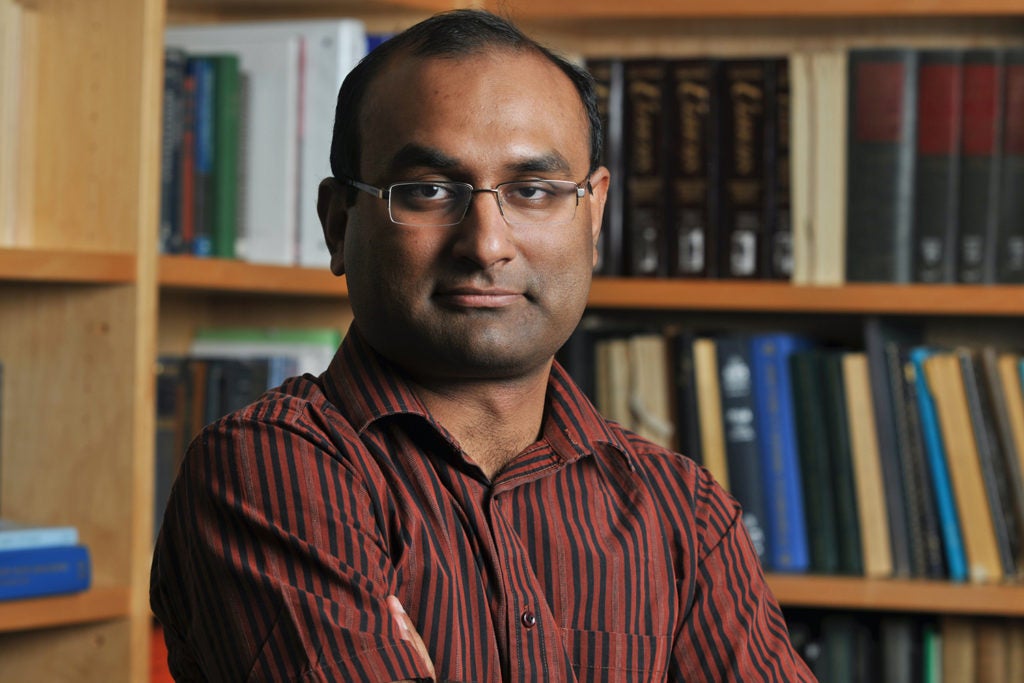Stanford’s Sourav Chatterjee awarded prestigious mathematics prize
Chatterjee's significant contributions in pure and applied mathematics range from social networks to quantum mechanics.
Growing up in India, Sourav Chatterjee was “always into math and math-y things,” he says, from programming computers to playing chess. With Chatterjee’s aptitude matching his zeal, he became a world-renowned mathematician, joining Stanford University as a professor of mathematics and statistics in the School of Humanities and Sciences in 2013.
Now in a full-circle connection with his original home country, Chatterjee has received the Infosys Prize in Mathematical Sciences. The $100,000 award, which recognizes outstanding researchers and scientists of Indian origin, is presented by the Infosys Science Foundation, a nonprofit founded by Infosys, an Indian multinational digital services and consulting corporation. Through the award, the Foundation aims to encourage the spread of science in India, particularly among young people. The Infosys Prize in Mathematics was first given in 2008.
“I’m very honored and humbled to receive this prize,” said Chatterjee, who first came to Stanford as a doctoral student in 2002 after earning bachelor’s and master’s degrees from the Indian Statistical Institute in Kolkata. “It means a lot to be recognized by the group of esteemed mathematicians assembled by The Infosys Science Foundation, and I feel encouraged to continue pushing ahead with my research.”
Rooted in probability and statistics, Chatterjee’s work has had significant impacts not only in mathematics but also broadly in physics, technology and other fields. Across his many papers, Chatterjee has devised novel mathematical approaches for scientists to apply in their own research. “One of the big guiding practices in my work has been making mathematical tools other people can use,” Chatterjee said.
Topics that have benefitted from his mathematical insights include occurrences of rare events, the dynamics of social as well as technological networks, the behavior of magnets and efforts to further solidify a mathematical basis for quantum mechanics.
Two common themes in these topics are uncertainty about an outcome and complexity of the overall system. As a branch of mathematics, probability cuts to the heart of these situations. In a social network, for example, any two people may be friends, or connected to a certain numerically definable way; the complexity grows as various groups of friends emerge with overlapping connections and with varying strengths of connections.
Distilling a problem to its figurative nuts and bolts is an appealing challenge that Chatterjee has undertaken again and again. Reflecting both this range of applications and the helpfulness of Chatterjee’s work, the jury of the Infosys Science Foundation, composed of academics from around the world, described Chatterjee as “one of the most versatile probabilists of his generation” and praised his “formidable problem-solving powers.”
For his part, Chatterjee said he appreciates the recognition of his fellow mathematicians but credits his mentors, teachers, family and friends for helping him achieve the success he’s had.
What’s next
Chatterjee’s work is far from done. At any given time, he says he has in the ballpark of seven to eight mathematical problems on his mind. “I have this school of problems swimming around in my head – some in probability, some in statistics, some in physics – that I’d love to solve,” Chatterjee said.
Most of these problems he has spent years cogitating over, revisiting from time to time, occasionally making progress, other times hitting fresh dead ends. But every now and then, “something just clicks,” he said.
“When you’re going to have this one mathematical idea that is a leap, it’s completely unpredictable,” he added. “I might be taking a shower, or driving my car. But that moment when the big idea comes, it’s just amazing.”
To read all stories about Stanford science, subscribe to the biweekly Stanford Science Digest.
